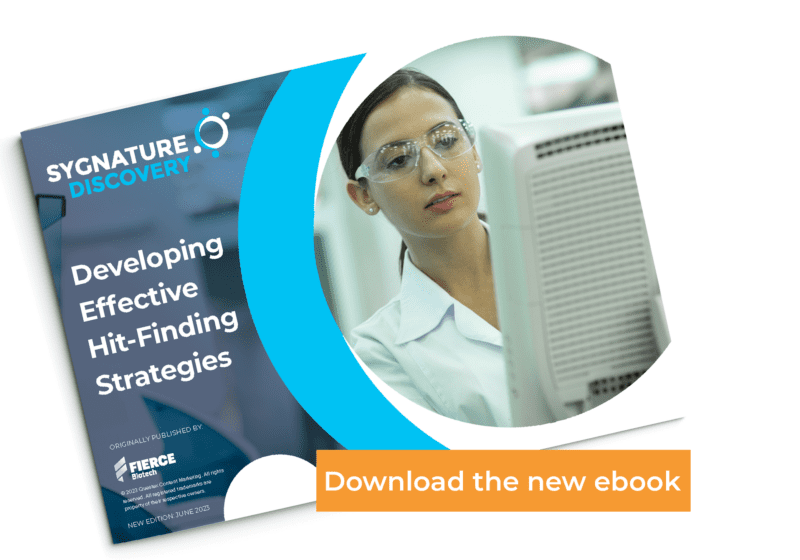Hit Validation for Suspicious Minds
Regardless of the target or modality, all drug discovery programmes commence with some form of hit finding. From a knowledge-based approach building on prior art, high-throughput screening, a DNA-encoded library screen, fragment screening or computational approaches. But, irrespective of this, a key challenge remains: how can you determine if your hit is truly a hit? In this article, our VP of Oncology Drug Discovery, Allan Jordan and Principal Scientists from our Assay Development team, Alex Stowell and Chris Tomlinson, share their insights and experiences on the subject.
Drug discovery is a long and arduous journey. However, when a new target with compelling disease linkage is discovered it’s a journey all involved are keen to start. On identification of initial chemical hits, there’s a strong desire to quickly progress those hits toward something of clinical utility…
But, as Elvis sagely noted back in 1961, “Wise men say, only fools rush in…” Taking time at an early stage to validate the activity of potential hits can save months down the line. This may ultimately be the difference between success and failure.
Novel targets bring new challenges…
The last decade has seen a transformational shift in the mindset of what is “undruggable”. As we make progress tackling proteins like KRas, and transcription factors like c-Myc and even explore the possibility of targeting RNA, we are challenging this concept. Such targets may be redefined as “complex to drug”. But these more complex targets bring new challenges, particularly in hit validation and can be particularly sensitive to assay interference artefacts. Though hits may appear to show believable structure-activity relationships with the target, it may be better to ‘return to sender’ for these molecules.
The needle in the haystack
We have encountered projects where high throughput screening of over a million compounds resulted in the identification of a single validated hit compound. These projects have demanded the use of multiple hit-finding approaches, to eventually unveil real hit compounds. And this process took years instead of the expected months. But when the biology is compelling, and the patient’s need is great, this tenacity is clearly justified. And several of these projects have taken those lonely singleton hits all the way through to clinical evaluation.
However, numerous factors initially overshadowed the genuine singleton hit, making it less conspicuous. Compound series with apparent SAR and tractable chemistry is clearly attractive for prosecution and are hard to ignore. But here, we need to be patient and trust our biology colleagues to work their magic and reveal the true hits.
Discover the latest eBook, ‘Developing Effective Hit-Finding Strategies,’ and explore in-depth insights on hit-finding strategies.
Which hits are good hits?
The PAINs literature[1] has significantly raised awareness of a multitude of avenues for false positive mechanisms. These include compound and protein aggregation, redox inactivation of our targets, fluorescent interference and other factors. Furthermore, GSK’s groundbreaking research has uncovered several further unexpected causes of these rogue actors [2]. These range from metal ion impurities to carry-over from our purification techniques actually introducing active impurities…
What has all this taught us? Most importantly, patience is clearly virtuous in the critical validation stage. There are several vital steps we feel are crucial to success in the hit validation process.
We advocate that hits:
- Should have their activity re-confirmed from re-synthesised and/or re-purified material, with structural confirmation, not just from re-purchased solid stock
- Should display some outline SAR, ideally both positive and negative, and with at least a half-log change of activity in each direction
- Should give sensible bioactivity curves with meaningful and reasonable hill slopes
- Should be risk-assessed for PAINs motifs computationally and assessed practically for redox potential and interference using orthogonal assay readouts
- Should be assessed for their potential to aggregate, or aggregate the target of interest
- Should have solubility in a range commensurate with the observed activity
The most crucial aspect to remember is that each target is unique, presenting its own distinct challenges and potential risks. The design of this validation cascade will be specific to the target and must be driven by the data at hand. Expert assay and hit validation efforts early on can yield substantial benefits in the later stages of the project. It enables us to prioritize truly valid hits and advance them towards meaningful therapeutics, rather than wasting time on plausible but misleading data. As Elvis might say, those false hits might look like an angel, but are likely to be the devil in disguise!
[1] Baell et al., Nature, 2014, 513, 481-483
[2] Chkravorty et al, SLAS Discovery, 2018, 23(6), 532-545

